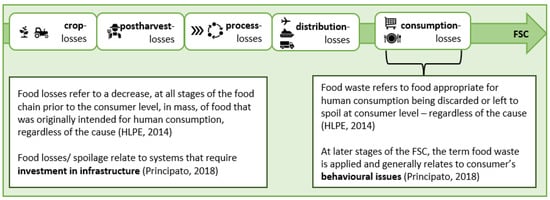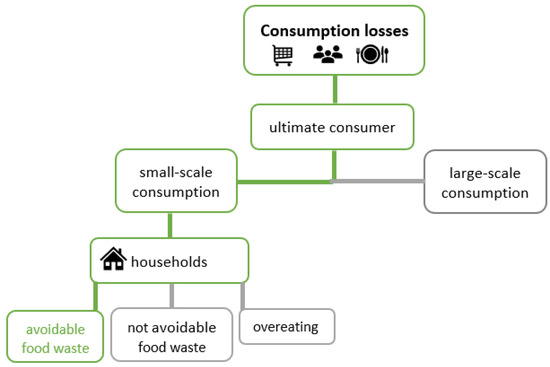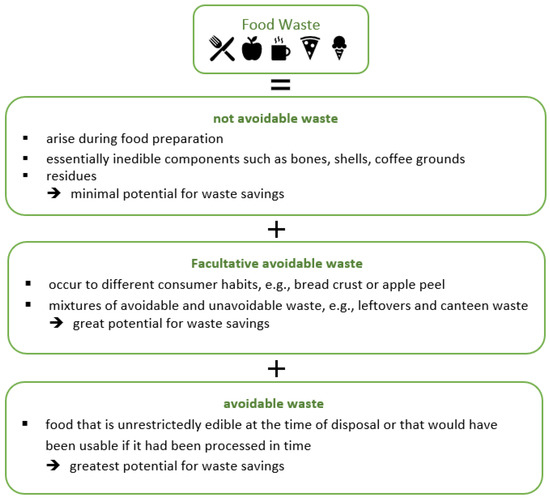Your browser does not fully support modern features. Please upgrade for a smoother experience.
Please note this is an old version of this entry, which may differ significantly from the current revision.
Subjects:
Others
According to the Food and Agriculture Organization (FAO), about 1.3 billion tons of food, equivalent to one-third of worldwide food production, is lost or wasted. Along the value chain, food loss and waste (FLW) occur at every stage, including production, transportation, storage, processing, retailing, and consumption. Compared to developing countries, very few post-harvest losses occur in developed countries due to technical progress. However, in developing countries, about 40% of the total FLW comes from households.
- household food waste
- avoidable food waste
- food waste composition
1. Objectives for Reducing FLW
- (1)
-
Food security is the main objective for many societies. According to the United Nations’ Committee on World Food Security, food security defines a situation in which all people, at all times, have physical, social, and economic access to sufficient, safe, and nutritious food that meets their food preferences and dietary needs for an active and healthy life. FLW reduction or prevention can potentially help to move up food security, in particular in developing countries where food security is often crucial. Nonetheless, donations to food banks can also contribute to the reduction of FLW and improve the food security of endangered groups.
- (2)
- (3)
-
Environmental protection or economic sustainability is another important objective. Economic sustainability refers to practices for long-term economic growth without having negative impacts on social, environmental, or cultural levels. FLW often has negative effects on the environment, e.g., through landfills. The economic costs of landfills are mostly not incorporated in the cost of production or waste.
- (4)
-
For many people, FLW also has a moral dimension. FLW is considered to be unethical. A lack of appreciation of discarded food is contemplated to be morally unacceptable by many people. For instance, wasted meat is disrespectful of the animal lives taken. Many cultures honour respectful and FLW-minimising handling of foods [1,19].
2. Definition of FLW
To define FLW, we need a definition of food. The regulation of the European Parliament (EC) No. 178/2002 stipulates the general principles and requirements of food law. In Article 2 it says: “[…] food or foodstuff means any substance or product, whether processed, partially processed or unprocessed, intended to be, or reasonably expected to be ingested by humans.” [20].
Based on this definition, FAO (1981) defines that “FLW is wholesome edible material intended for human consumption, arising at any point in the food supply chain that is instead discarded, lost, degraded or consumed by pets” [21]. More recently HLPE defines FLW as “a decrease, at all stages of the food (supply) chain from harvest to consumption, in mass, of food that was originally intended for human consumption, regardless of the cause” [6]. FLW can occur at the production, post-harvest, and processing stages of the food supply chain (FSC) [15] referring to a decrease of food for human consumption, regardless of the cause of their disposal [1,6]. These losses can be categorised according to their origin. A distinction is made between food loss (FL) and food waste (FW) [1,15,22] (see Figure 1). FW occurs at the end of the value chain at the level of household consumption, whereas FL occurs at previous stages of the supply chain [6,19,21].

FW can be further differentiated according to its potential of avoidance into: avoidable, facultative avoidable and unavoidable waste [15] (see Figure 2).
As in many industrialised countries, consumers in Germany are responsible for most of the FLW within the FSC. Consumers include households (small consumers) and large consumers such as canteens and restaurants. FW results from consumers’ behaviour and attitudes. Thereby it is also manipulated by retailing practices such as promotions and price and quantity discounts [19,24]. “Overeating” of consumers may also be considered as FW [25] (see Figure 3).

Figure 3. Consumption losses.
3. Approaches to Estimate FLW
- (1)
- (2)
-
Waste composition analyses (WCA) focus on a sorting system for household waste. WCA are complex and expensive. Only FW disposed of via the municipal waste system is documented. The WCA have limits in identifying foods and their kinds [27]. The awareness of being part of an FW study may lead to behavioural changes (“Hawthorne effect”) [2,12].
- (3)
-
In food waste diaries household members document the amount of FW during a certain period. FW diaries require the time and effort of participants. Results, however, may be comparatively more accurate than surveys. Households may still adjust their behaviour [30,31,32]. In contrast to WCA, FW diaries allow to analyse the waste composition and its determinants. Food fed to animals, disposed in the sewer, or composted is documented. Some household FW may even not be noted, e.g., food is taken to and wasted at the office or school [12]. Though often overrated, the share of unavoidable waste is estimated [13,33].
- (4)
-
Meta-analyses are based on the results of other primary surveys or extrapolations. The main strength of this method is the access to large amounts of data, which could facilitate comparability.
Here, we combine questionnaire-based surveys and FW diaries to detect both reliable quantities and drivers of FW and to obtain information about households. The diary method is expected to be more accurate than the questionnaire. Participants of the diary-study document avoidable FW.
4. Causes of Consumer FW
Several studies show that household waste behaviour has various determinants and interdependencies [1,5,13,25,29]. Different driving forces like incorrect understanding of best-before-dates, little overview on stocks, poor time management, and insufficient planning which causes quality problems, such as little knowledge and competence of preparation as well as re-use of leftovers lead to FW. Moreover, children’s eating habits can also foster FW [5,6,13,34,35,36]. Further, consumer preferences, eating habits, and socio-economic settings can foster FW. Many consumers prefer freshness, variation, and variety of food. A lack of awareness and education increases FW [4,37]. In many high-income countries, food is relatively cheap and often additionally put on promotional sales by retailers. Due to specials, promotions and bigger pack sizes consumers feel forced to buy beyond actual demand [38]. Causes lead to the actual reasons why food is disposed of. Consumers state that they dispose of food due to qualitative deficiencies (e.g., freshness, brown spots on the apple, or dry bread), or due to exceeded best-before-dates. Food is often wasted because consumers fear foodborne diseases or consumers are unable to assess food born health risks. Consumers feel that wasting food even prior the best-before-date reduces health risks [13,25,29,34,39,40,41]. If, however, self-determination and freedom of choice are assumed for consumers, the observed FLW may be the result of utility maximising [41]
This entry is adapted from the peer-reviewed paper 10.3390/ijerph192114253
This entry is offline, you can click here to edit this entry!

